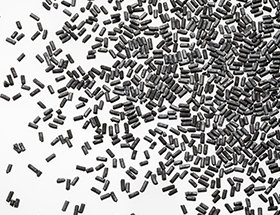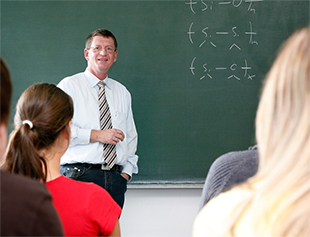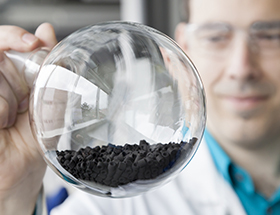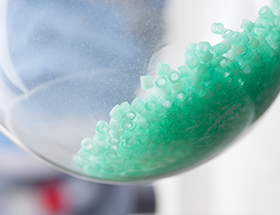iC4 - Electricity on Tap
Over the past three years, WACKER has been working on a major project in partnership with other renowned companies and research institutes: storing energy generated by renewable sources. The researchers want to convert surplus green electricity into methane gas. This would allow the energy to be stored easily in the natural-gas grid or in gas caverns. The greenhouse gas carbon dioxide acts as an aid.
Storing Energy Generated by Wind, Sun or Biomass
December 2014 was a stormy month, so German wind turbines generated more electricity than ever before. 14 powerful low-pressure areas – from Alexandra to Zoe – and numerous new offshore wind farms ensured that 8.9 billion kilowatt hours were fed into the German power grid. As a result, wind energy even outperformed nuclear power.
What happens when the sun isn’t shining and the wind doesn’t blow?
But what happens when the sun isn’t shining and the wind doesn’t blow? Fluctuating green electricity yields are one of the energy transition’s unsolved problems. Experts are desperately searching for a solution that will allow energy generated by wind, the sun or biomass to be stored. Just like a squirrel stocks up on winter supplies, it should be possible to store solar energy for when the days are short. After all, we want electricity to be available from our sockets at all times, wherever we are – regardless of whether the sun is shining or not.
Dr. Alexander Zipp hopes to solve this problem. “I’ve always been somewhat environmentally minded,” he says modestly. Over recent years, the young chemist has enthusiastically supported the iC4 project at WACKER, in which science and industry are joining forces to research the conversion of green electricity into synthetic natural gas (see box). “Storing energy is obviously a major problem,” says Zipp, his expression serious behind his protective glasses. “This makes it even more exciting to be involved in finding a solution.”

The surface area of one kilogram of the carrier is almost as large as 30 soccer fields.
Catalysts
Catalysts make chemical reactions possible and accelerate them. For the methanation process, the catalyst support made of HDK® pyrogenic silica is impregnated with metal particles and then ensures that carbon dioxide and hydrogen combine to form methane gas as efficiently as possible. The catalyst must be stable and resistant to impurities and heat.
Since the chemical reaction only takes place at the catalytically active surface of the catalyst, the catalyst also needs to have as large a surface area as possible. During his research work at WACKER, Dr. Alexander Zipp has calculated that the surface area of one kilogram of the carrier is almost as large as 30 soccer fields.
Opportunities for the Chemical Storage of Energy
How can surplus energy generated by wind and the sun be stored long-term? There are various different approaches. “But only the existing gas grid and gas reservoirs really make sense for seasonally storing large amounts of energy,” says chemistry professor Bernhard Rieger of the Technical University of Munich (TUM). In his opinion, batteries can, at best, store large quantities of electricity short-term, while new pumped storage power plants are unpopular with the general public, and building huge new hydrogen tanks would entail enormous effort and expense.
That’s why the iC4 project partners have opted for chemical storage. Here, the first step involves water being separated into its components oxygen and hydrogen with the aid of surplus green electricity. Electrolysis plants for this are already available on an industrial scale. The hydrogen is then converted into methane with the aid of carbon dioxide, obtained, for example, from coal-fired power stations, cement factories or biogas plants. This step is important, because, unlike hydrogen, methane can easily be stored in large volumes. It is the main constituent (over 80 percent) of natural gas and can thus be fed into the gas grid or one of the many underground gas reservoirs.
How can surplus energy generated by wind and the sun be stored long-term?
“There are various different approaches. But only the existing gas grid and gas reservoirs really make sense for seasonally storing large amounts of energy.”
Professor Bernhard Rieger
Head of the WACKER Chair of Macromolecular Chemistry and
Director of the Institute of Silicon Chemistry
at the Technical University of Munich

The chemistry underlying this power-to-gas technology has long been established. However, carbon dioxide reacts so slowly that, for a long time, nobody seriously considered commercializing methanation. The process was not economically feasible. The researchers of the iC4 group are now putting their hearts and souls into optimizing key components for the process in order to make methanation more cost-effective.
“Our goal was to develop a membrane that separates gases better than any other membrane process.”

Dr. Christian Anger
Chemist at WACKER’s
central research division.
Dr. Christian Anger is one of the young WACKER employees involved in the global competition for energy storage systems of the future. The 30-year old works in a modern building on the grounds of WACKER’s central R&D facility – the Consortium – in Munich’s Obersendling area. Here, over 160 employees are working on megatrends, such as battery components, better processes for photovoltaic materials, and higher-performance materials for wind power. And materials for energy-storage systems.
As part of the iC4 project, Anger and his team have developed a membrane for separating carbon dioxide from waste gas. This will allow the greenhouse gas CO2, which is generated in power plants, cement factories and biogas plants, to be recycled. “Our goal was to develop a membrane that separates gases better than any other membrane process,” says Anger. The membrane is still being put through its paces by cooperation partner Linde. “We already know that our silicone materials are quite well suited to the support structure of the membrane,” says research group head Dr. Jürgen Stohrer. “However, it is not yet clear if and where they will be used to develop products.”
Catalysts Are at the Heart of the Process
A few doors down, Zipp is shaking a screw-top jar full of hollow ceramic cylinders, irradiated by sunlight passing through his lab’s long window front. “This could be the key to economical methane production,” says the 39-year-old. The small, white, hollow cylinders made of HDK® pyrogenic silica constitute the support from which catalysts for the conversion of hydrogen and carbon dioxide into methane are made.
These small catalysts must be able to do a lot: they have to convert the starting materials into methane as completely as possible. Furthermore, they must be able to withstand moisture, temperature fluctuations, and any impurities in the carbon dioxide. “CO2 from power plants is not pure, but contains substances that can affect the catalyst,” explains Stohrer. Moreover, the catalysts must work well for years. “After all, a catalyst charge for a production reactor costs several million euros,” explains Zipp.
Even though Zipp and his team are only looking after one aspect of the iC4 project, it is an important part. “Tailor-made catalysts and catalyst supports are at the heart of the process,” says Stohrer, who is coordinating iC4 work at WACKER with key project partners. The company can offer decades of knowledge here, as the chemical group has been manufacturing pyrogenic silica since 1969.
“Avoiding CO2 emissions and storing electricity are strategic, future-oriented topics.”

Dr. Arndt Schlosser
Head of R&D processes
Is it possible that the success of the transition toward renewable energy sources actually depends on these inconspicuous catalyst supports? Prof. Rieger believes this to be a likely possibility. “WACKER has developed completely new support systems for the catalysts,” says the renowned scientist, who heads the iC4 project. “This has allowed us to make considerable progress with this type of electricity storage.” The chemist sees iC4 as one of his most successful projects: “Here, the right people are at the right place at the right time.”
That’s music to Dr. Arndt Schlosser’s ears. He is responsible for innovation management at WACKER and establishes research partnerships with top-class scientists around the world. To him, the iC4 project fits in very well with corporate strategy, since energy is a key growth market for WACKER. “Avoiding CO2 emissions and storing electricity are strategic, future-oriented topics,” he explains. “Over the coming years, nobody will exactly be doing major business in this field,” says Schlosser. “But anyone who wants to be involved in these topics in the future must get on board early.”
“Because we really believe in what we are doing here.”
iC4 is one of the long-term topics in WACKER’s innovation portfolio. “Here, we are free to look at more than just the next set of quarterly figures,” says research manager Schlosser. The prudent chemist believes that this is an important prerequisite for sustainable business practices, as such projects do not just benefit the environment. “When we look for long-term business models that will allow us to continue earning money and providing jobs for our employees in the future, we are acting in a totally sustainable manner,” says Schlosser, adding with a smile: “This is, after all, how WACKER has managed to succeed for 100 years.”
His colleague Stohrer is not normally inclined to be emotional about these things. He is a scientist, after all. Nevertheless, his expression reveals that he is impressed with the WACKER researchers’ commitment over recent years. “Our young project managers and their teams have really gotten involved – it’s a highly emotional affair,” he says. “Because we really believe in what we are doing here.”
Stohrer shares the feeling that iC4 is a special project. “Something has to be done about climate protection, we all know that,” he says emphatically. He believes that the work on chemical storage has paid off: “We now know how it works and that it works.” However, according to Stohrer, when and if this will be commercialized depends on politics and energy prices. TUM professor Rieger definitely sees potential. He says: “Pilot plants could be up and running by 2020. And the technology must be well-established by 2030.”
iC4
By 2050, the plan is for 80 percent of electricity in Germany to be supplied by renewable energy sources. This is the German federal government’s target. That’s why the Federal Ministry of Education and Research (BMBF) has, over recent years, supported many research projects aimed at advancing the energy transition. One of the flagship projects is iC4, sponsored with €6.3 million from 2012 to 2015: surplus green electricity is to be converted into methane gas with the aid of carbon dioxide and stored in the gas grid.
iC4 stands for integrated carbon capture, conversion and cycling. Alongside eight institutes at the Technical University of Munich and the Fraunhofer Institute for Interfacial Engineering and Biotechnology, chemical companies WACKER and Clariant, as well as E.ON, Siemens, Linde and the reactor specialists at MAN’s DWE site in Deggendorf, are on board. WACKER is heading two of the four subprojects.
Further Information: ic4.tum.de
Target for 2050
of electricity from renewable energies

Federal Ministry of Education and Research


